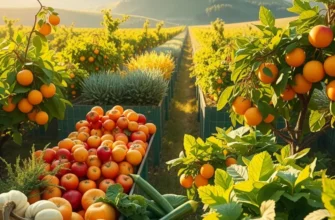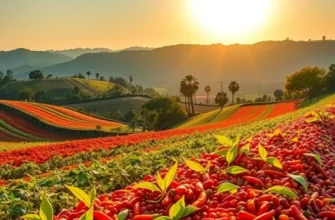Latin America is a vibrant tapestry of cultures, each contributing richly to its diverse culinary landscape. From bold spices to familial cooking traditions, this region offers food enthusiasts a thrilling exploration of flavors and techniques deeply rooted in history. Engage with the cultural narratives behind iconic dishes that define countries and communities, showcasing the harmony between agriculture and culinary artistry. The journey through Latin American food traditions promises to tantalize your taste buds and enrich your understanding of global cuisine.
The Heart of Latin Cuisine: Ingredients and Influences

Latin American cuisine is a vibrant mosaic of flavors, deeply rooted in the lands’ rich natural resources and cultural exchanges across centuries. Understanding the ingredients that make up this tapestry is essential in appreciating the culinary artistry of the region.
One cannot start a conversation about Latin American ingredients without paying homage to the bold chili peppers of Mexico. These fiery spices, which range widely in heat and flavor, are used both fresh and dried, and serve as the backbone of many regional dishes. From the smoky depth of chipotle to the sweet brightness of guajillo, each pepper holds its own personality, contributing layers of complexity to everything from salsas to sauces.
Moving south to the Andes, the potato reigns as a staple ingredient. Originating high in the Peruvian Andes, this humble tuber has made its way around the world, but in its homeland, an astonishing variety still exists. With over 4,000 types grown, potatoes in the Andes come in a near-endless array of colors, shapes, and sizes, each lending a unique texture and taste to traditional stews and side dishes.
In Brazil, the tropical climate blesses the land with an abundance of fresh produce, including açai berries and exotic fruits like passionfruit and papaya. These fruits feature prominently in both sweet and savory dishes, providing a balance of tartness and sweetness. Additionally, the use of herbs such as cilantro and parsley is pivotal in Brazilian cuisine, particularly in seasoning fish dishes along the Atlantic coast.
Herbs and spices are the unsung heroes, infusing dishes with life and warmth. Cumin, a spice introduced during the Spanish conquest, is now an inseparable part of Latin cooking, used in seasoning blends throughout the region. The delicate anise-like notes of epazote, native to Mexico, add an unmistakable aroma to bean dishes and soups.
The exchange of ingredients through trade routes has introduced elements that have become integral to Latin American cooking. For instance, the arrival of garlic, onions, and various other spices from Europe and Asia transformed local cuisines, merging with indigenous techniques and ingredients to create dishes that are both innovative and deeply traditional.
To truly appreciate the diversity and unity of Latin American flavors, one must recognize how these ingredients are more than just food items; they are cultural touchstones. These foundational elements reflect the history, resilience, and creativity of the peoples of Latin America.
For those looking to explore substitutes or enhance flavors without excess salt, you might find alternative flavor boosters helpful. These insights can offer new ways to experience the vibrant tastes of these essential Latin ingredients in your own kitchen.
Festivals on Your Plate: Celebrations and Shared Meals

Festivals and shared meals in Latin America are more than just an opportunity to eat. They encapsulate the essence of tradition, storytelling, and community bonding. Across the continent, every country boasts unique celebrations where food plays a central role, acting as a vehicle for cultural expression and unity.
Take the vibrant Día de los Muertos in Mexico, for instance. This festival is a time of colorful altars, marigold decoration, and lively music, celebrating the lives of the departed. Central to this commemoration is Pan de Muerto, a sweet bread that holds symbolic meaning. Its round shape symbolizes the cycle of life and death, while the bone-shaped decorations atop it are a homage to ancestors. Families gather to prepare these breads along with tamales and sugar skulls, fostering an environment of remembrance and connection.
In Argentina, the Asado is more than just a cooking technique; it’s a social event deeply embedded in their culture. This traditional barbecue brings people together to share stories and laughter, uniting friends and family with grilled meats and chimichurri sauce. The preparation itself is a communal affair. The Asador, or grill master, is a revered figure, carefully tending to the large cuts of beef, chorizo, and morcilla. As the meats sizzle on the grill, so do the conversations around, creating bonds that reaffirm cultural heritage.
Food at these gatherings often transcends its culinary components. It becomes symbolic, a bearer of memories and stories. The sharing of a meal facilitates the recounting of folklore, fostering a deeper appreciation for one’s roots. Whether it’s Abuela’s recipe for mole passed through generations or the alignment of mixing grains and spices for a communal feast, these narratives bind people and imbue them with a sense of belonging.
Food safety and preservation are also critical when organizing these large, festive meals. Ensuring the proper storage of ingredients and leftovers can be essential to the sustainable practice of these traditions. For tips on safer storage methods, one might explore strategies to ensure minimal waste and maximize the enjoyment of these culinary gatherings here.
In conclusion, the culinary practices observed during festivals in Latin America highlight the profound role of food as a cultural anchor. Through communal meals, individuals are not only nourished physically but also culturally and socially, ensuring that their identities remain vibrant and celebrated. Food is the thread weaving together festivals and familial gatherings, creating a tapestry of shared human experience across generations.
Final words
Latin American food traditions represent a beautiful intersection of culture, history, and community. By celebrating local ingredients and embracing shared meals, these culinary practices offer food enthusiasts an opportunity to connect with the rich narratives of diverse cultures. From family gatherings to vibrant festivals, every dish tells a story, emphasizing the importance of heritage and communal bonds in shaping Latin America’s culinary identity. Through this journey, you not only taste a range of unique flavors but also appreciate the cultural significance behind each dish that enhances global culinary traditions.








